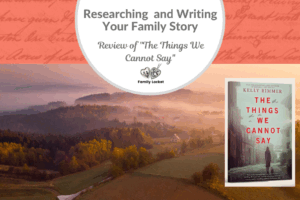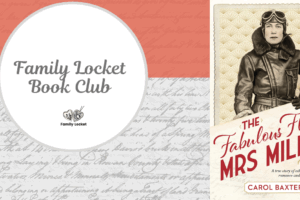
Reading historical fiction based on fact allows us to follow an engaging story and learn history simultaneously. The Indigo Girl by Natasha Boyd fulfills both possibilities. Who was Eliza Lucas Pinckney, the woman the novel is based on? She is credited with learning to grow the difficult crop of indigo in South Carolina in the early 1700s, which was a challenging task, especially for a woman in Colonial America.
We’re reading The Indigo Girl for the spring selection of the Family Locket Book Club on Goodreads. If, like me, you didn’t know about Eliza, indigo, or Charlestown, South Carolina, in the early 1700s, the book will give you insight into the plight of a woman in this time. Eliza’s story is remarkable and well worth reading.
Who was Eliza Lucas Pinckney?
 Eliza was born in 1722 to George and Ann Lucas on the island of Colonial British Antigua, where Lucas served as Lieutenant Governor. Her parents sent her to England for her education, where she developed a love of botany. When her father moved her family to the Lowcountry near Charleston, South Carolina, in about 1738, Eliza was a young woman. With her mother’s death soon after they arrived in the colony and her father’s departure for Antigua soon after, Eliza was left with the management of three plantations and the enslaved workers.
Eliza was born in 1722 to George and Ann Lucas on the island of Colonial British Antigua, where Lucas served as Lieutenant Governor. Her parents sent her to England for her education, where she developed a love of botany. When her father moved her family to the Lowcountry near Charleston, South Carolina, in about 1738, Eliza was a young woman. With her mother’s death soon after they arrived in the colony and her father’s departure for Antigua soon after, Eliza was left with the management of three plantations and the enslaved workers.
Eliza’s interest in botany became apparent with her desire to plant more than rice, and she experimented with seeds her father sent her from the Caribbean islands. At this time, indigo was a valuable crop in the islands, but no one had successfully grown it in South Carolina yet. Eliza persisted with the difficult task of growing indigo and then extracting the dye—a laborious process, especially in the heat and humidity.
Eliza came to know Charles Pinckney and his wife, Elizabeth Lamb Pinckney, through their association with Charlestown society. Although twenty years her senior, when Elizabeth died, Charles married Eliza and had four children with her. Charles died in 1758 of malaria, and following his death, Eliza continued to manage the plantation work while raising their children. Because of Eliza’s success with indigo, other Lowcountry planters followed suit, and by the Revolution, indigo comprised a third of South Carolina’s exports.
Eliza died at age 71 in 1793 of breast cancer, and her family buried her in Philadelphia.
Eliza Lucas Pinckney left a lasting legacy in the Lowcountry. In 1989, Eliza was the first woman inducted into the South Carolina Business Hall of Fame, for her contributions to agriculture and economic growth. In 2008, she was inducted in the South Carolina Hall of Fame.1
Researching Eliza
 Eliza left behind letterbooks that describe her life up until the mid-1760s. After that, historians have turned to newspaper articles and the writings of her friends and family to learn about her later years. Much has been written about Eliza, from biographies to children’s fiction.
Eliza left behind letterbooks that describe her life up until the mid-1760s. After that, historians have turned to newspaper articles and the writings of her friends and family to learn about her later years. Much has been written about Eliza, from biographies to children’s fiction.
Natasha Boyd uses these letters throughout The Indigo Girl, bringing Eliza to life.
The author writes,
Now, I realize I am not a historian. But I do know that there once lived a remarkable girl whose name, outside of Charleston, has mostly been forgotten. And the need to tell her story became so overwhelming that I couldn’t ignore it. I told myself that if I could tell her story in such a way as to capture her spirit and her fire, and introduce her back into our consciousness, then I must try.”2
The Letterbook of Eliza Lucas Pinckney, 1739-1762, provides insight into her character, daily activities, and thoughts and sets a foundation for The Indigo Girl. What is a letterbook? The introduction to The Letterbook of Eliza Lucas Pinckney states:3
One legacy of Eliza’s educational breadth is this published letterbook itself. Her handwritten letterbook served as a record of drafts of outgoing communications, brief memoranda of them, and copies of finished letters. . . . this unique volume offers today’s reader a rare opportunity to come vis-a-vis a woman in Colonial America.
Historical research by the author provided the context that filled in the blanks. Author Natasha Boyd shared a sampling of her research process on her Instagram account. I was fascinated to see the timeline she created – much like what we do in our genealogy research. She researched historical records, maps, clothing, and, importantly, the process of growing indigo and producing its blue dye. Be sure to check out the images at @eliza.the_indigo_girl
Natasha Boyd also researched onsite in the Lowcountry – attending an indigo exhibit, viewing the Eliza Luca Pinckney exhibit in Charleston, and immersing herself in the culture of the time. The extraordinary exhibit at the Charleston Museum ran in 2023. Still, through the article ” A Legacy in Silk: Eliza Lucas Pinckney’s Robe a la Francaise,” we can view photos of Eliza’s dress and shoes. The dress was donated in 1940 by a direct descendant. The museum has also created a video to walk us through the story: Eliza Lucas Pinckney’s Robe à la Française with Virginia Theerman, Curator of Historic Textiles
Writing our Family Stories
Natasha Boyd provides an example of how we can write our family stories through her immersion in Eliza’s life. Imagine if you visited a blacksmith shop and spent a day doing the work. You’d certainly have new insight into that ancestor. What can we learn from studying the community of our ancestor? What did they wear? What did they eat? How did they travel? Our ancestors may not have left letters, diaries, or even many records of their lives, but with enough research and context, we can reconstruct a probable reality for them.
Best of luck in all your genealogical endeavors!
Sources
- “Eliza Lucas Pinckney,” Charles Pinckney National Historic Site South Carolina, updated 12 February 2025, National Park Service (https://www.nps.gov/chpi/learn/historyculture/eliza-lucas-pinckney.htm : accessed 21 March 2025).
- Natasha Boyd, The Indigo Girl (Ashland, Oregon: Blackstone Publishing, 2017), author’s note.
- Eliza Pinckney, Marvine R. Zahniswer ed., The Letterbook of Eliza Lucas Pinckney, 1739-1762 (Charleston: The South Carolina Historical Society, 1997), x.














Leave a Reply
Thanks for the note!